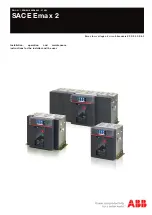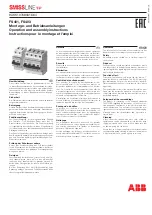
18
ABB Power Distribution
7.3
Servicing
7.3.1
Switching devices in general
If cleaning is found to be necessary during
inspections as set out in 7.2.1, the following
procedure is to be adopted:
• Prior to cleaning, the working area is to be
isolated and secured against reclosing where
necessary in accordance with the safety
regulations of DIN VDE/IEC.
• Cleaning of surfaces in general:
– Dry, lightly adhering dust deposits with a soft,
dry cloth.
– More strongly adhering contamination with
slightly alkaline household cleanser or Rivolta
BWR 210.
• Cleaning of the insulating material surfaces and
conductive components:
– Light contamination:
with Rivolta BWR 210.
– Strongly adhering contamination:
with cold cleanser 716.
Wipe down after cleaning, using clean water,
and dry properly.
• Observe the manufacturer's instructions and the
special ABB instruction manuals Ba 1002/E or
BA 1006/E on safety at work.
Note:
Use only halogen free cleansers, and in no case
1.1.1-trichlorethane, trichlorethylene or carbon
tetrachloride!
7.3.2
Stored-energy spring mechanism
Servicing or the spring mechanism is to be
performed after 10,000 operating cycles.
Prior to servicing, switch the breaker off, and isolate
the outgoing feeder.
Observe the safety regulations!
Details of the servicing:
• Swich off the charging motor (if fitted), and
discharge the spring energy storage mechanism
by closing and opening the breaker once.
• Replace parts subject to high climatic and
mechanical stresses after 10,000 operating
cycles as a precaution (for details see ABB Calor
Emag after-sales service).
• For replacing highly stressed parts neutralize
bysic tension of the spiral spring, state the rate.
Be careful when carrying out!
• Relubricate pawls, support shafts, sliding and
rotating bearing surfaces. Lubricant: Isoflex To-
pas NB 52.
• Check the fit of fasteners (e.g. locking pins) in
cranks, pins, bolts etc. Check the tightness of
fastening bolts.
• Always replace any spring lock washers, split
pins and other fasteners removed during the
work with new parts when reassembling the
equipment.
• Check the general condition of the operating
mechanism and recharge the spring energy
store.
• Perform comprehensive mechanical and
electrical functional tests.
• Ensure that the bolted joints at the contact
locations of the conductor bar system and the
earthing connections are tight.
Note:
This work may only be performed by the after-sales
service personnel of ABB Calor Emag Mittel-
spannung GmbH or adequately qualified personnel.
7.3.3
Breaker pole
The breaker pole with the vacuum interrupter is
maintenance-free up to reaching the permissible
number of vacuum interrupter operating cycles in
accordance with section 2.4.
Checking of the vacuum is only necessary when
there is good cause to suspect that force applied
externally to a pole tube has caused damage to the
vacuum interrupter inside.
If the pole tube is damaged or destroyed, it may be
necessary to replace the complete breaker pole.
The working life of the vacuum interrupter is defined
by the sum current limit corresponding to the
equipment data in individual cases in accordance
with section 2.4:
• When the sum current limit is reached, the
complete breaker poles are to be replaced.
• When the permissible number of mechanical
operating cycles (i.e. the number corresponding
to I
a
=0 on the characteristic curve) of the
vacuum interrupters has been reached, the
breaker poles must be replaced. However, it
should be investigated beforehand as to
whether the installation of a new breaker would
be more advantageous.
For testing the vacuum without dismantling the
circuit-breaker you may use:
• Vacuum tester VIDAR,
from Programma Electric GmbH,
Bad Homburg v.d.H.
A test DC voltage of 60 kV is to be set for testing of
the pressure inside the interrupter chamber with
vacuum tester VIDAR.
Testing is to be performed at the rated contact
distance in the OFF condition.







































